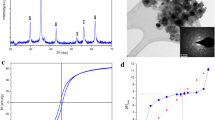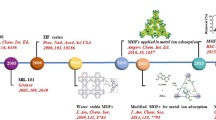Abstract
Nanoparticles offer the potential to improve environmental treatment technologies due to their unique properties. Adsorption of metal ions (Pb(II), Cd(II), Cu(II), Zn(II)) to nanohematite was examined as a function of sorbent concentration, pH, temperature, and exhaustion. Adsorption experiments were conducted with 0.05, 0.1, and 0.5 g/L nanoparticles in a pH 8 solution and in spiked San Antonio tap water. The adsorption data showed the ability of nanohematite to remove Pb, Cd, Cu, and Zn species from solution with adsorption increasing as the nanoparticle concentration increased. At 0.5 g/L nanohematite, 100 % Pb species adsorbed, 94 % Cd species adsorbed, 89 % Cu species adsorbed and 100 % Zn species adsorbed. Adsorption kinetics for all metals tested was described by a pseudo second-order rate equation with lead having the fastest rate of adsorption. The effect of temperature on adsorption showed that Pb(II), Cu(II), and Cd(II) underwent an endothermic reaction, while Zn(II) underwent an exothermic reaction. The nanoparticles were able to simultaneously remove multiple metals species (Zn, Cd, Pb, and Cu) from both a pH 8 solution and spiked San Antonio tap water. Exhaustion experiments showed that at pH 8, exhaustion did not occur for the nanoparticles but adsorption does decrease for Cd, Cu, and Zn species but not Pb species. The strong adsorption coupled with the ability to simultaneously remove multiple metal ions offers a potential remediation method for the removal of metals from water.





Similar content being viewed by others
References
Ali I, Gupta VK (2007) Advances in water treatment by adsorption technology. Nat Protoc 1(6):2661–2667
Chen C, Wang X (2006) Adsorption of Ni(II) from aqueous solution using oxidized multiwall carbon nanotubes. Ind Eng Chem Res 45:9144–9149
Chen Y-H, Li F-A (2010) Kinetic study on removal of copper(II) using goethite and hematite nano-photocatalysts. J Colloid Interface Sci 347:277–281
Cornell R, Schwertmann U (1996) The iron oxides: structure, properties, reactions, occurrence and use. Weinheim, New York
Donat R, Akdogan A, Erdem E, Cetisli H (2005) Thermodynamics of Pb2+ and Ni2+ adsorption onto natural bentonite from aqueous solutions. J Colloid Interface Sci 286:43–52
Doula M, Ioannou A, Dimirkou A (2000) Thermodynamics of copper adsorption–desorption by Ca-kaolinite. Adsorption 6:325–335
Engates K (2010) Characterization, sorption, and exhaustion of metal oxide nanoparticles as metal adsorbents. University of Texas at San Antonio, San Antonio, 159 pp
Engates KE, Shipley HJ (2011) Heavy metal removal using titanium dioxide anatase nanoparticles and bulk media. Environ Sci Pollut Res 18:386
Gupta VK, Carrott PJM, Ribeiro Carrott MML, Suhas (2009) Low-cost adsorbents: growing approach to wastewater treatment—a review. Crit Rev Environ Sci Technol 39(10):783–842
Gupta VK, Rastogi A (2001) Process development for the removal of lead and chromium from aqueous solutions using red mud—an aluminum industry waste. Water Res 35(5):1125–1134
Gupta VK, Ali I (2004) Removal of lead and chromium from wastewater using bagasse fly ash—a sugar industry waste. J Colloid Interface Sci 271(2):321–328
Gupta VK, Ali I, Saini VK (2007) Defluoridation of wastewaters using waste carbon slurry. Water Res 41(15):3307–3316
Gupta VK, Rastogi A, Nayak A (2010) Adsorption studies on the removal of hexavalent chromium from aqueous solution using a low cost fertilizer industry waste material. J Colloid Interface Sci 342(1):135–141
Gupta VK, Nayak A (2012) Cadmium removal and recovery from aqueous solutions by novel adsorbents prepared from orange peel and Fe2O3 nanoparticles. Chem Eng J 180:81–90
Grover V, Hu J, Engates K, Shipley H (2012) A study of hematite nanoparticles for metal remediation: adsorption, desorption, and regeneration. Environ Toxicol Chem 31:86–92
HACH Company (2008) HACH water analysis handbook procedures. HACH, Loveland
Hu J, Lo M, Chen G (2004) Removal of Cr(IV) by magnetite nanoparticle. Water Sci Technol 50:139–146
Hu J, Chen G, Lo I (2005) Removal and recovery of Cr(VI) from wastewater by maghemite nanoparticles. Water Res 39:4528–4536
Hu J, Chen G, Lo I (2006) Selective removal of heavy metals from industrial wastewater using maghemite nanoparticle: performance and mechanisms. J Environ Eng 132:709–715
Huang Y-H, Hsueh C-L, Huang C-P, Su L-C, Chen C-Y (2007) Adsorption thermodynamic and kinetic studies of Pb(II) removal from water onto a versatile Al2O3-supported iron oxide. Sep Purif Technol 55:23–29
Li Y-H, Di Z, Ding J, Wu D, Luan Z, Zhu Y (2005) Adsorption thermodynamic, kinetic and desorption studies of Pb2+ on carbon nanotubes. Water Res 39:605–609
Lisha K, Anshup PT (2009) Towards a practical solution for removing inorganic merucry from drinking water using gold nanoparticles. Gold Bulletin 42(2):144–152
Liu W-T (2006) Nanoparticles and their biological and environmental applications. J Biosci Bioeng 102:1–7
Liu Y (2008) New insights into pseudo-second-order kinetic equation for adsorption. Colloids Surf, A Physicochem Eng Asp 320:275–278
Masters G, Ela W (2007) Introduction to environmental engineering and science. Prentice Hall, Englewood Cliffs
Morterra CJ (1988) An infared spectroscopic study on anatase properties. Part 6. Chem. Soc., Faraday Trans 84:1617–1622
Oxtoby D, Freeman W, Block T (1998) Chemistry: science of change. Saunders College Publishing, Orlando
Özcan A, Özcan A (2004) Adsorption of acid dyes from aqueous solutions onto acid-activated bentonite. J Colloid Interface Sci 276:39–46
Pan B, Zhang Q, Meng F, Li X, Zhang X, Zheng J, Zhang W, Chen J (2005) Sorption enhancement of aromatic sulfonates onto an aminated hyper-cross-linked polymer. Environ Sci Technol 39:3308–3313
Pan B, Qiu H, Pan B, Nie G, Xiao L, Lv L, Zhang W, Zhang Q, Zheng S (2010) Highly efficient removal of heavy metals by polymer-supported nanosized hydrated Fe(III) oxides: behavior and XPS study. Water Res 44:815–824
Ponder S, Darab J, Mallouk T (2000) Remediation of Cr(VI) and Pb(II) aqueous solutions using supported, nanoscale zero-valent iron. Environ Sci Technol 34:2564–2569
Rebhun M, Galil N (eds) (1990) Wastewater treatment technologies: the management of hazardous substances in the environment. Elsevier, London, pp 85–102
Rodda D, Johnson B, Wells J (1996) Modeling the effect of temperature on adsorption of lead(II) and zinc(II) onto goethite at constant pH. J Colloid Interface Sci 184:365–377
Sawyer C, McCarty P, Parkin G (2003) Chemistry for environmental engineering and science. McGraw-Hill, New York
Schindler PW (1981) Surface complexes at oxide–water interfaces. In: Anderson MA, Rubin AJ (eds) Adsorption of Inorganic at solid–liquid Interfaces. Ann Arbor Science, Ann Arbor, pp 1–49
Seki Y, Yurdakoç K (2006) Adsorption of promethazine hydrochloride with KSF Montmorillonite. Adsorption 12:89–100
Shipley H, Yean S, Kan A, Tomson M (2009) Adsorption of arsenic to magnetite nanoparticles: effect of particle concentration, pH, ionic strength, and temperature. Environ Toxicol Chem 28:509–515
Shipley HJ, Sujin Yean, Amy T. Kan, Mason B. Tomson (2010) A sorption kinetics model to predict arsenic adsorption to magnetite nanoparticles. Environ Sci Pollut Res 17:1053
Shipley H, Engates K, Guettner A (2011) Study of iron oxide nanoparticles in soil for remediation of arsenic. J Nanopart Res 13:2387–2397
Smith J, Van Ness H, Abbott M (eds) (1996) Introduction to chemical engineering thermodynamics. McGraw-Hill, New York
Stumm W, Morgan JJ (1996) Aquatic chemistry: 3rd ed. Geochimica et Cosmochimica Acta, 60, 1200 pp
Tratnyek P, Johnson R (2006) Nanotechnologies for environmental cleanup. Nano Today 44:48
UNEP, DEWA/GRID-Europe (2005) E-waste, the hidden side of IT equipment’s manufacturing and use
USEPA (2006) 2006 Edition of the Drinking Water Standards and Health Advisories. In: Water (Hrsg.). EPA, Washington, D.C
USEPA (2008) Nanotechnology for site remediation: fact sheet EPA 542-F-08-009. EPA, Washington
WHO (2005) Nickel in drinking water: background document for development of WHO Guidelines for Drinking-Water Quality. WHO, New York
Yadava K, Tyagi B, Singh V (1991) Effect of temperature on the removal of lead(II) by adsorption on China clay and wollastonite. J Chem Technol Biotechnol 51:47–60
Yantasee W, Warner C, Sangvanich T, Addleman R, Carter T, Wiacek R, Fryxell G, Timchalk C, Warner M (2007) Removal of heavy metals from aqueous systems with thiol functionalized superparamagnetic nanoparticles. J Environ Sci Technol 41:5114–5119
Yu Y, Zhuang Y-Y, Wang Z-H (2001) Adsorption of water-soluble dye onto functionalized resin. J Colloid Interface Sci 242:288–293
Acknowledgments
We acknowledge financial support from the National Science Foundation through the Broadening Participation Research Initiation Grant in Engineering (EEC-0823685) and the Center for Water Research at UTSA.
Author information
Authors and Affiliations
Corresponding author
Additional information
Responsible editor: Vinod Kumar Gupta
Electronic supplementary material
Below is the link to the electronic supplementary material.
Fig. S1
Speciation diagram of Pb(II), Cu(II), Cd(II), and Zn(II) of 1,000 μg L−1 in aqueous solution at 22°C (calculated using MINTEQ; docx 42 kb)
Rights and permissions
About this article
Cite this article
Shipley, H.J., Engates, K.E. & Grover, V.A. Removal of Pb(II), Cd(II), Cu(II), and Zn(II) by hematite nanoparticles: effect of sorbent concentration, pH, temperature, and exhaustion. Environ Sci Pollut Res 20, 1727–1736 (2013). https://doi.org/10.1007/s11356-012-0984-z
Received:
Accepted:
Published:
Issue Date:
DOI: https://doi.org/10.1007/s11356-012-0984-z




